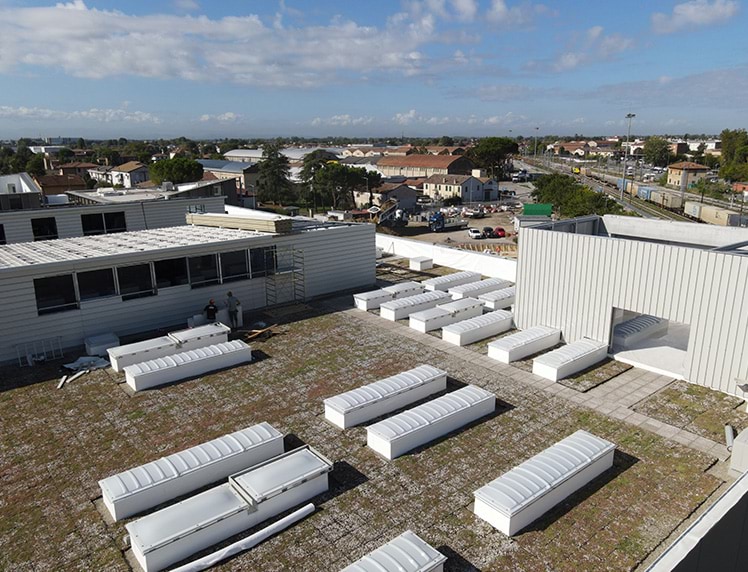A green roof's unique conformation means it needs a specific and particularly reliable waterproofing system. Polyglass has developed two main waterproofing systems: one using prefabricated distillate polymer bitumen membranes and one with prefabricated FPO/TPO (flexible polyolefin) membranes.
A green roof is generally a complex build-up system involving several layers, each with its own specific function. Polyglass systems come complete with all the required elements, from primers and vapour barriers to waterproofing membranes or sheaths, and even separating layers and drainage geocomposites are included.
Both solutions (bitumen and synthetic) are CE certified and are resistant to root penetration (EN 13948). They also offer high mechanical strength, which is essential, especially at the garden construction stage.
The typical build-up of a green roof waterproofed with bituminous and synthetic membranes is relatively simple. The key functional layers are described below.

Load-bearing structural support
The load-bearing structural support must be sized to withstand permanent loads and accidental overloading resulting from the weight of the actual garden itself, the weight of irrigation water and the weight of people and equipment required for its maintenance in the event the roof is an amenity space.
Various kinds of load-bearing structural support can be used, such as a traditional or prefabricated reinforced concrete deck, a composite steel deck or timber deck.
Depending on the green roof design, the load-bearing structure can have a slope varying from steep to shallow, or may even have no slope (in the latter case, the slope will be created with concrete screed or with suitably arranged insulating panels).
Levelling layer
The purpose of the levelling layer is to level out and compensate for protuberances and unevenness in the surface the roof is being installed on in order to avoid the risk of the waterproofing membrane being punctured.
This layer is produced using geotextiles with a suitable weight and relevant properties.
Root-resistant waterproofing layer
The purpose of the waterproofing layer is to stop rainwater and irrigation water getting inside, as well as protecting the load-bearing structural support from deterioration.
This layer must also be resistant to penetration by roots that it might come into contact with.
Protection layer
The purpose of the protection layer is to protect the waterproofing layer from mechanical damage.
The waterproofing system is exposed to the risk of mechanical damage both during the building of the actual garden and while it is in service. There are green roof systems that, given the nature of the materials and/or systems, do not require this layer to be built or already have protection built in.
Drainage or drainage/water storage layer
The purpose of the drainage layer is to allow excess rainwater or irrigation water to drain away so that the growing medium does not become saturated, which could compromise the correct development of the vegetation's root system.
Many green roof systems feature a water storage layer incorporated into the drainage layer so as to have a reserve of water for "bottom-up" irrigation of the vegetation.
The water storage means sprinkler irrigation can be used at greater intervals and, in certain favourable situations, irrigation can be done away with altogether.
Filter layer
The purpose of the filter layer is to stop the growing medium from being wash away and thus clogging and compromising the operation of the drainage layer or drainage/water storage layer.
Growing substrate
This is the growing medium, more specifically the natural substrate comprising a blend of soils in which the roof's vegetation can grow and survive.
Vegetation
Vegetation must be chosen carefully, taking into account the environmental conditions and various factors that can affect its development and survival, such as local climate, exposure, the roof's use and maintenance requirements.
Building a more complete and well-structured green roof involves the use of certain complementary elements, as described below.

Vapour barrier layer
To be included in the building of a green roof with thermal insulation.
The purpose of this layer is to control the flow of vapour passing through the structure, from the inside of the building to the outside, in order to avoid the issue of condensation forming inside the roof assembly.
It must be applied under the thermal insulation layer.
Thermal insulation layer
To be applied when building thermally insulated green roofs.
This layer can be produced using the various usual commercially available insulating materials.
Suitable compressive strength is one essential requirement of this layer, which must also be compatible with the waterproofing membrane to be applied on top.
Erosion control/soil-retention systems or layer
Erosion control/soil-retention systems are used when producing green roofs on pitched roofs. Their purpose is to stop the growing medium from slipping and eroding when laid on a slope.
Irrigation system
The purpose of the irrigation system is to supplement the water that vegetation on the roof is receiving from rainfall in order to ensure correct plant growth and survival.
Various kinds can be used, from sprinkler systems - with fixed or oscillating sprinklers - to soaker hoses, drip lines or sub irrigation to water from the bottom up. If used in conjunction with a water storage layer, the irrigation system required may be much smaller or watering times may be reduced considerably.
Reference standards
Every country has specific reference standards for green roofs.
For example, after years at the study stage, the Italian standard UNI 11235: Instructions for the design, installation, control and maintenance of green roofs was finally introduced in 2007, and later reviewed and amended in 2015.
The standard defines design, installation, control and maintenance criteria for continuous green roofs, depending on the specific context in terms of climate, building type and intended use.